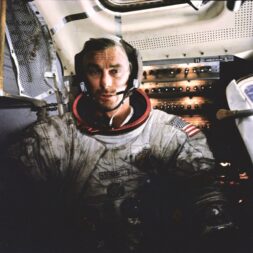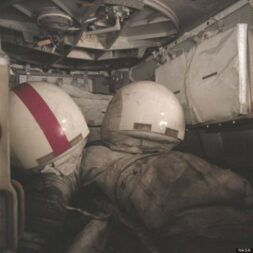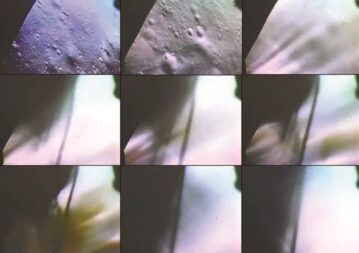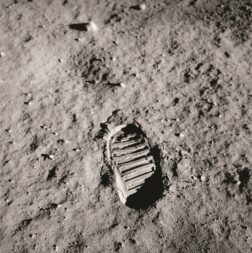Science
Dealing with dust: A back-to-the-moon dilemma – SpaceNews

If the political, technical and budgetary stars align for NASA and its partners in coming years, the moon could be the go-to place as the century unfolds. Astronauts would again explore Earth’s celestial next-door neighbor, perhaps setting in motion future mining endeavors to extract ices likely lurking in sunlight-shy craters for processing into water, oxygen, and rocket propellant. Humans that “settle in” on the moon could well be a future prospect.
The next chapter in the U.S. human exploration of the moon, the Artemis Project, will dispatch crews there for extended periods of time, building upon Apollo’s heritage. Between 1969 and the end of 1972, a dozen astronauts kicked up the powdery regolith, the topside dirt of the moon. But there’s one flash back message from the Apollo moonwalkers worth heeding: the place is a Disneyland of dust.
During their landings, dust blown up into the thin lunar atmosphere impacted astronaut visibility. Once crews were out and about on the moon, the dust had deleterious effects on their spacesuits, helmets, equipment and instrumentation. Apollo expedition members could not escape tracking lunar material inside their lunar landers. After doffing their helmets and gloves, moonwalkers could feel the abrasive nature of the dust, even experiencing an “Apollo aroma” — a distinctive, odoriferous smell.
As explained by Apollo 17’s moon landing crew:
“I think dust is probably one of our greatest inhibitors to a nominal operation on the moon. I think that we can overcome other physiological or physical or mechanical problems except dust,” said mission commander Eugene Cernan. “One of the most aggravating, restricting facets of lunar surface exploration is the dust and its adherence to everything no matter what kind of material, whether it be skin, suit material, metal, no matter what it be and its restrictive friction-like action to everything it gets on,” said lunar module pilot and geologist, Harrison Schmitt.
AGENCY, INDUSTRY CONCERN
Study groups and technologists are assessing ways to lessen the negative impact of lunar dust on the astronauts, their equipment, and surface operations.


Joel Levine, a research professor in applied science at The College of William and Mary in Williamsburg, Virginia, was convener and chair of a NASA workshop on lunar dust and its impact on human exploration. The message from that workshop held in February was clear. “Prior to the first Artemis human landing on the moon, we must better understand the particle size distribution, structure, chemical composition, potential toxicity, magnetic and electrical properties and the dynamics and distribution of lunar dust,” he said.
The workshop findings were published Sept. 24 as a NASA Engineering and Safety Center Technical Assessment Report, stating that the dust problem “is an agency and industry concern affecting most mission subsystems and it must be addressed.” The report also said that it is crucial that measurements and experiments be taken and carried out on the lunar surface by precursor landers to find out dust characteristics “that will influence hardware design, and provide toxicology data to safeguard crew health.”
PROTECTING LUNAR GEAR
Future machinery on the moon will be presented challenges, said Gerald Sanders, an expert on in-situ resource utilization (ISRU) for NASA’s Space Technology Mission Directorate at Johnson Space Center in Houston. Unlike other equipment and instruments that operate on the moon, ISRU systems and hardware need to operate continuously and in direct contact with lunar regolith and dust for very long periods of time. It is vital, he said, to develop techniques and technologies to resist abrasion, to safeguard optical coatings, as well as protect rotating mechanisms. In the end, easily replaceable components in lunar-situated gear will be critical.


“While the Apollo missions and samples returned to Earth have provided a wealth of information, it will not be until the VIPER rover enters a permanently shadowed region that we will get a true sense of what the regolith is like to design future ice mining equipment,” Sanders said. NASA’s Volatiles Investigating Polar Exploration Rover, or VIPER, is a mobile robot that will go to the moon’s south pole, perhaps as early as December 2022 under NASA’s Commercial Lunar Payload Services program.
Philip Metzger, a planetary physicist with the Planetary Science faculty at the University of Central Florida, has focused his research on dust transport and its effects due to landing spacecraft on the moon.
“Lunar lander engine exhaust blows dust, soil, gravel, and rocks at high velocity and will damage surrounding hardware such as lunar outposts, mining operations, or historic sites unless the ejecta are properly mitigated,” said Metzger.
Decades of research have developed a consistent picture of the physics of rocket exhaust blowing lunar soil, “but significant gaps exist,” Metzger added. “No currently available modeling method can fully predict the effects. However, the basics are understood well enough to begin designing countermeasures.”
Metzger is principal investigator for the Ejecta Sheet Tracking, Opacity, and Regolith Maturity (STORM) instrument, set to fly on a Masten Space Systems Xodiac vertical takeoff and vertical landing system. The upcoming flight in Mojave, California, will gauge the density and sizes of particles that churn up during terrestrial simulations of lunar landings.
INTEGRATED DUST MITIGATION STRATEGY
NASA wants to place the first woman and next man at the lunar south pole in 2024. That location is advocated as a future base camp given possible access to ice and other mineral resources. However, still unknown are the true physical properties of the lunar dust and regolith in the polar regions.


Jorge Núñez of the Planetary Exploration Group at Johns Hopkins University Applied Physics Laboratory (APL) in Laurel, Maryland, said a host of questions need to be tackled. “We can approximate and extrapolate based on the data we already have, but we will not really know until we land in those regions,” he said.
“As we learned from the Apollo missions, lunar dust can cause a wide range of issues, including being a hazard to astronaut health, sticking to all kinds of surfaces like spacesuits, visors and windows, solar panels, and radiators,” Núñez said. Lunar dust also degrades seals, fabrics, and mechanisms. Dealing with dust is going to require an “integrated dust mitigation strategy,” he added, such as using slow, methodical movements and allow adequate time for dust cleaning protocols, as well as keeping spacesuits outside of the pressurized habitat or lunar rover, to utilizing an electrodynamic dust shield to repel dust off materials.
Núñez said that NASA’s Lunar Surface Innovation Initiative is accelerating the development of many of these dust mitigation technologies that are important for enabling human missions on the surface of the moon.
MOON SIMULANTS
The reactive nature of lunar dust to humans is another area flagged by APL’s Karl Hibbitts, lead facilitator for the ISRU focus group of the Lunar Surface Innovation Consortium. The lunar dust has been known to be troublesome in this area since the Apollo era. The particles are chemically very reactive, he said, thus the potential health concern (although various passivation techniques to make them less reactive are being explored).


“We have attempted to study the reactivity of lunar soils in the lab,” Hibbitts said, “but the studies I know of have all been on samples already altered by the Earth’s atmosphere. The new studies on carefully curated lunar soils will hopefully shed some new insights.” Furthermore, as far as “simulants” go — concoctions of made-on-Earth material to imitate the properties of the lunar regolith — one has to choose which properties one needs the simulants to mimic. “It’s not possible to create literally tons of lunar soil, or possibly even a small amount. Facilities are just now learning how to make realistic agglutinates,” he added, and yet to be reproduced is the nanophase metallic iron that’s resident in the moon’s regolith.
“We’re getting better at approximating the shape and size distribution function, but the reactivity could only be mimicked by production in a vacuum chamber and will always be limited to tiny quantities,” Hibbitts told SpaceNews.
So far, human contact with tiny, very sharp, glassy lunar dust particles only occurred briefly during the Apollo missions, said Peter Sim, an emergency medicine specialist in Newport News, Virginia. But in returning to the moon and establishing a long-term presence, lunar dust, in sufficient doses, represents a “toxic threat” to human health, he said.
The respiratory system is particularly susceptible, Sim said, but the eyes, skin, and possibly the gastrointestinal tract and other organs may also be affected. Primary prevention of human exposure to lunar dust “should be our number one goal,” he advised.
He added that NASA’s new Exploration Extravehicular Mobility Unit (xEMU) spacesuit will help keep the dust at bay. It has a group of dust-tolerant features, to prevent inhalation, or contamination of the suit’s life support system. Still, keeping habitats dust-free by minimizing incursions, and using effective atmospheric filtration systems, will be a major challenge. “Monitoring of the dust that is present inside lunar habitats will be crucial, since the hab is the place where astronauts are most likely to be exposed. Because of this, the quantity, size, and potential toxicity of the ‘hab dust’ is of paramount importance,” he said.
SpaceNews contributor Leonard David is the author of “Moon Rush: The New Space Race” published by National Geographic in May 2019.
This article originally appeared in the Dec. 14, 2020 issue of SpaceNews magazine.
Science
April 20: Why this Indigenous researcher thinks we can do science differently and more… – CBC.ca


Quirks and Quarks54:00Why this Indigenous researcher thinks we can do science differently, and more…
On this episode of Quirks & Quarks with Bob McDonald:
This researcher wants a new particle accelerator to use before she’s dead
Quirks and Quarks9:05This researcher wants a new particle accelerator to use before she’s dead
Physicists exploring the nature of reality need ever more capable particle colliders, so they’re exploring a successor to the Large Hadron Collider in Europe. But that new machine is at least decades away. Tova Holmes, an assistant professor at the University of Tennessee, Knoxville, is one of the physicists calling for a different kind of collider that can come online before the end of her career – or her life. This device would use a particle not typically used in particle accelerators: the muon.
Is venting the best way to deal with anger? The scientist says chill out.
Quirks and Quarks6:51Is venting the best way to deal with anger? The scientist says chill out
It turns out that acting out your anger might not be the best way to get rid of it. Sophie Kjaervik, a researcher at Virginia Commonwealth University in Richmond, Va., analyzed 154 studies of the different ways to deal with anger. Her results, published in the journal Clinical Psychology Review, suggest that techniques that reduce your heart rate and calm your mind are more effective than blowing off steam.
High intensity wildfires may release toxic forms of metals
Quirks and Quarks8:37High intensity wildfires may release toxic forms of metals
Wildfire smoke might be more dangerous than you think. A recent study in the journal Nature Communications found that when wildfires pass over soils or rocks rich in a normally harmless metal called chromium, it is transformed into a toxic form. The hotter and more intense the wildfire is, the more of this metal becomes toxic. Scott Fendorf, an Earth system science professor at Stanford University, said this study shows we should factor in the type of geology wildfires pass over to provide more targeted air quality warnings about smoke risks.
AI might help solve the problem of runaway conspiracy theories
Quirks and Quarks7:35AI might help solve the problem of runaway conspiracy theories
Conspiracy theories seem to have multiplied in the internet era and so far, we haven’t had much luck in debunking these beliefs. The preliminary findings of a new study on PsyArXiv, a site for psychology studies that have yet to be peer-reviewed, suggests that artificial intelligence may have more success. Thomas Costello, a postdoctoral psychology researcher at MIT was the lead author on this study, and said their findings can provide a window into how to better debunk conspiracy beliefs.


An Indigenous scientist explores the medicine the Earth needs
Quirks and Quarks19:12An Indigenous ecologist on why we need to stop and listen to save the planet
Earth day is April 22. And Earth is not in great shape to celebrate the day. Overheated, overpopulated, overexploited – we’re not being particularly careful with our planet. We talk to Indigenous ecologist Jennifer Grenz of the University of British Columbia about her new book, which is part memoir, part prescription for the medicine our planet needs – a compound of science and traditional wisdom. Her book is Medicine Wheel for the Planet: A journey toward personal and ecological healing.
READ MORE: An Indigenous ecologist on why we need to stop and listen to save the planet


Science
Dragonfly: NASA greenlights most important mission of the century – Earth.com


In a remarkable development, NASA has given the green light to the Dragonfly mission, a revolutionary rotorcraft designed to investigate the complex chemistry of Saturn‘s moon Titan.
This confirmation allows the mission to proceed with the final design, construction, and testing of the spacecraft and its scientific instruments.
Deciphering the prebiotic chemistry on Titan
The Dragonfly mission, led by Dr. Melissa Trainer of NASA’s Goddard Space Flight Center, will carry a cutting-edge instrument called the Dragonfly Mass Spectrometer (DraMS).
This powerful tool will help scientists delve into the intricate chemistry at work on Titan, potentially shedding light on the chemical processes that led to the emergence of life on Earth, known as prebiotic chemistry.
“We want to know if the type of chemistry that could be important for early pre-biochemical systems on Earth is taking place on Titan,” explains Dr. Trainer, a planetary scientist and astrobiologist specializing in Titan.
Titan: Dragonfly’s target
Titan, the largest moon of Saturn, is shrouded in a dense nitrogen-rich atmosphere, bears a striking resemblance to Earth in many ways. With a diameter of 5,150 kilometers, Titan is the second-largest moon in our solar system, surpassed only by Jupiter’s Ganymede.
Dense atmosphere and unique climate
One of Titan’s most distinctive features is its thick atmosphere, which is composed primarily of nitrogen and methane. This dense atmosphere creates a surface pressure 1.5 times higher than Earth’s, making it the only moon in our solar system with a substantial atmosphere.
The presence of methane in Titan’s atmosphere leads to a fascinating hydrological cycle, similar to Earth’s water cycle, but with methane as the primary liquid.
Titan’s surface is dotted with numerous lakes and seas of liquid hydrocarbons, predominantly methane and ethane. These liquid bodies, some of which are larger than the Great Lakes on Earth, are the result of Titan’s unique climate and atmospheric conditions.
The Cassini mission, which explored the Saturn system from 2004 to 2017, provided stunning images and data of these extraterrestrial lakes and seas.
Dragonfly mission to search Titan for prebiotic chemistry and life
The complex chemistry occurring on Titan’s surface and in its atmosphere has drawn significant attention from astrobiologists.
With its abundant organic compounds and the presence of liquid methane, Titan is considered a prime candidate for studying prebiotic chemistry and the potential for life to emerge in environments different from Earth.
Beneath Titan’s icy crust lies another intriguing feature: a global subsurface ocean of liquid water and ammonia. This ocean, which is believed to be salty and have a high pH, may potentially host microbial life.
The presence of this subsurface ocean, along with the unique chemistry on Titan’s surface, makes this moon a fascinating target for future exploration and scientific research.
Pushing the boundaries of rotorcraft exploration
Nicky Fox, associate administrator of the Science Mission Directorate at NASA Headquarters, emphasized the significance of the Dragonfly mission, stating, “Exploring Titan will push the boundaries of what we can do with rotorcraft outside of Earth.”
Titan’s unique characteristics, including its abundant complex carbon-rich chemistry, interior ocean, and past presence of liquid water on the surface, make it an ideal destination for studying prebiotic chemical processes and the potential habitability of an extraterrestrial environment.
Innovative design and cutting-edge technology
The Dragonfly robotic rotorcraft will leverage Titan’s low gravity and dense atmosphere to fly between different points of interest on the moon’s surface, spanning several miles apart.
This innovative approach allows the entire suite of instruments to be relocated to new sites once the previous one has been thoroughly explored, providing access to samples from diverse geological environments.
DraMS, developed by the same team responsible for the Sample Analysis at Mars (SAM) instrument suite aboard the Curiosity rover, will analyze surface samples using techniques tested on Mars.
Dr. Trainer emphasized the benefits of this heritage, stating, “This design has given us an instrument that’s very flexible, that can adapt to the different types of surface samples.”
Dragonfly mission challenges and funding
The Dragonfly mission successfully passed its Preliminary Design Review in early 2023. However, due to funding constraints, the mission was asked to develop an updated budget and schedule.
The revised plan, presented and conditionally approved in November 2023, hinged on the outcome of the fiscal year 2025 budget process.
With the release of the president’s fiscal year 2025 budget request, Dragonfly is now confirmed with a total lifecycle cost of $3.35 billion and a launch date set for July 2028.
This reflects a cost increase of approximately two times the initially proposed cost and a delay of more than two years from the original selection in 2019.
Despite the challenges posed by funding constraints, the COVID-19 pandemic, supply chain issues, and an in-depth design iteration, NASA remains committed to the Dragonfly mission.
Additional funding has been provided for a heavy-lift launch vehicle to shorten the mission’s cruise phase and compensate for the delayed arrival at Titan.
Rigorous testing and validation
To ensure the success of the Dragonfly mission, researchers on Earth have conducted extensive testing and validation of the designs and models for the nuclear-powered, car-sized drone.
The mission team has carried out test campaigns at NASA’s Langley Research Center, utilizing the Subsonic Tunnel and the Transonic Dynamics Tunnel (TDT) to validate computational fluid dynamics models and gather data under simulated Titan atmospheric conditions.
Ken Hibbard, Dragonfly mission systems engineer at APL, emphasized the importance of these tests, stating, “All of these tests feed into our Dragonfly Titan simulations and performance predictions.”
As the Dragonfly mission progresses, it marks a new era of exploration and scientific discovery. Dr. Trainer expressed her excitement, saying, “Dragonfly is a spectacular science mission with broad community interest, and we are excited to take the next steps on this mission.”
Turning science fiction into fact with the Dragonfly mission
In summary, the Dragonfly mission embodies the essence of human curiosity and the relentless pursuit of knowledge. As NASA prepares to send this revolutionary rotorcraft to the alien world of Titan, we stand on the brink of a new era of exploration and discovery.
With its innovative design, cutting-edge technology, and the unwavering dedication of the mission team, Dragonfly will unlock the secrets of prebiotic chemistry and shed light on the potential for life beyond Earth.
As we eagerly await the launch of this titanic mission, we can only imagine the wonders that await us on Saturn’s enigmatic moon. The Dragonfly mission is a testament to the indomitable human spirit and our boundless capacity to push the frontiers of knowledge.
In the words of Ken Hibbard, “With Dragonfly, we’re turning science fiction into exploration fact,” and that fact will undoubtedly inspire generations to come.
—–
Like what you read? Subscribe to our newsletter for engaging articles, exclusive content, and the latest updates.
Check us out on EarthSnap, a free app brought to you by Eric Ralls and Earth.com.
—–
Science
Marine plankton could act as alert in mass extinction event: UVic researcher – Langley Advance Times


A University of Victoria micropaleontologist found that marine plankton may act as an early alert system before a mass extinction occurs.
With help from collaborators at the University of Bristol and Harvard, Andy Fraass’ newest paper in the Nature journal shows that after an analysis of fossil records showed that plankton community structures change before a mass extinction event.
“One of the major findings of the paper was how communities respond to climate events in the past depends on the previous climate,” Fraass said in a news release. “That means that we need to spend a lot more effort understanding recent communities, prior to industrialization. We need to work out what community structure looked like before human-caused climate change, and what has happened since, to do a better job at predicting what will happen in the future.”
According to the release, the fossil record is the most complete and extensive archive of biological changes available to science and by applying advanced computational analyses to the archive, researchers were able to detail the global community structure of the oceans dating back millions of years.
A key finding of the study was that during the “early eocene climatic optimum,” a geological era with sustained high global temperatures equivalent to today’s worst case global warming scenarios, marine plankton communities moved to higher latitudes and only the most specialized plankton remained near the equator, suggesting that the tropical temperatures prevented higher amounts of biodiversity.
“Considering that three billion people live in the tropics, the lack of biodiversity at higher temperatures is not great news,” paper co-leader Adam Woodhouse said in the release.
Next, the team plans to apply similar research methods to other marine plankton groups.
Read More: Global study, UVic researcher analyze how mammals responded during pandemic
-
Media13 hours ago
DJT Stock Rises. Trump Media CEO Alleges Potential Market Manipulation. – Barron's
-
Media15 hours ago
Trump Media alerts Nasdaq to potential market manipulation from 'naked' short selling of DJT stock – CNBC
-
Investment14 hours ago
Private equity gears up for potential National Football League investments – Financial Times
-



 Sports18 hours ago
Sports18 hours ago2024 Stanley Cup Playoffs 1st-round schedule – NHL.com
-



 Investment23 hours ago
Investment23 hours agoWant to Outperform 88% of Professional Fund Managers? Buy This 1 Investment and Hold It Forever. – The Motley Fool
-
Business14 hours ago
Gas prices see 'largest single-day jump since early 2022': En-Pro International – Yahoo Canada Finance
-
Real eState6 hours ago
Botched home sale costs Winnipeg man his right to sell real estate in Manitoba – CBC.ca
-
Art17 hours ago
Enter the uncanny valley: New exhibition mixes AI and art photography – Euronews





